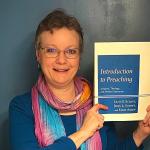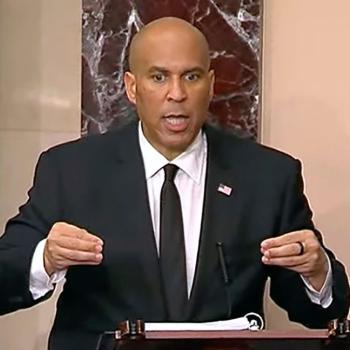Patheos blogger and Baptist pastor Jeff Hood wrote an excellent piece critiquing the placement of the American flag in the worship space. He begins by describing the kinds of worship services that fuse nationalistic fervor that some churches hold on or around patriotic holidays such as Memorial Day or Independence Day. Then he focuses on the highly problematic symbolism of draping a flag over the cross, and exegetes the conflicted messages such imagery conveys. He rightly calls such imagery blasphemous and calls for the American flag to be removed from the church. But my question is how?

How do we have this conversation about flag-placement in church?
As a former Lutheran parish pastor, and now a professor of preaching and worship, my concern is how we undertake this process of flag-removal. I have had many discussions with fellow clergy and my students about the question of whether or not it is appropriate to have a flag in the worship space. For many of them, this is one topic they will not dare bring up in their church for fear of the blow-back and negative responses from members who are often the pillars of the congregation.
Flag placement is one of the most delicate conversations to have in a church. Nationalism/patriotism has been so embedded into the religious psyche of Americans, trying to tease them apart is seemingly impossible (which is exactly what the Powers intended). Just trying to have this conversation is akin to heresy for some parishioners — especially those who have served, and those who lost loved ones in military service.
What not to do
As a pastor, I felt strongly that the flag should not be in the chancel area. So in one church I served, I tried moving it to the narthex. The next week it mysteriously appeared back in the chancel. So I moved it again. And again it walked back. This went on a few more times until I tried something different. I kept it in the sanctuary, but moved it to the back of the sanctuary in the corner, so it wasn’t visually part of the worship space, but still part of the sanctuary. This appeared to appease whoever the mystery mover was, because the flag stayed in that space after that.
Looking back, I don’t think I handled that situation well. I don’t recommend that a pastor take it upon themselves to suddenly move the flag of their own volition, simply because it can create unnecessary tension, and risks having a negative effect on pastoral relationships. Plus it bypasses the opportunity to build relationships, create “teachable moments,” and foster a culture of dialogue.

Flag placement in the church. Photo credit: Christdala Swedish Lutheran Church, Millersburg, MN. Audrey Kletscher Helbling. https://mnprairieroots.com/2010/09/ https://www.themonastery.org/blog/2017/05/trump-signs-executive-order-on-religious-freedom/
A healthier way to have the conversation
If a pastor were try to deal with flag placement in a healthier, more direct way, I would recommend the following:
1. Individual conversations and relationship-building
Identify the folks in the congregation who have served or are serving in the military, and develop relationships with them. Schedule pastoral visits with them and ask them to tell you their story (as much as they feel comfortable). This can be done with family members as well. The key is to develop trust, so that a later conversation about flag placement will not feel like an attack on them personally (because removing the flag can feel like invalidating them as a person, and their sacrifice).
2. Engage scripture
Once trust has been established (and this may take more than one pastoral visit), you can then ask to talk with them about these texts (Matthew 26:52 and Matthew 5:44) and others. The way I would approach it is to say something like this: “You know how much I honor your service to this country. And you know how much I value you as a member of this church and as a Christian. I’m wondering how you feel about these texts — as a member of the military/family member of the military — when you read them or hear them read in church? In other words, how do you reconcile what you’re called to do as a Christian, and what you’re called to do as a member of the military?”
3. Name the tension
Once trust has been established and scripture engaged, then I would ask if I could share my own struggles with this tension between Christianity and nationalism, as Jeff Hood has so succinctly described in his post. Here are some excerpts:
No one will recite Jesus’ words in Matthew 26:52, “…those who live by the sword will die by the sword.” Matthew 5:44 and Jesus’ reminder to “love our enemies and pray for those who persecute us” will not make an appearance. Least of all will we remember the millions and millions of people who have died in places with names like Hiroshima, Hanoi, Waziristan, Nagasaki, Kabul and Baghdad in the infernos created by our bombs…those “least of these” dead because we failed to see Jesus in their midst. No these words won’t be remembered… and I know most congregations won’t be talking beyond the soldiers who have died and will miss the opportunity to have a conversation about the wider call of Jesus to peace and justice. . .
To put the United States flag on the altar of a church is to insinuate that somehow the United States has a claim to the grace of God that other nations and peoples do not. To put the United States flag at the front blurs that glorious declaration “For God so loved the world…” Can you imagine what someone from another country thinks when they see that United States flag up front at our churches? There is no nationality barrier to the altar of God. Jesus does not love the United States more than any other nation…to put a flag at the front and bless the atrocities committed by an incredibly powerful people in the name of Jesus is blasphemous.
[For an even more provocative piece critiquing the fusion of nationalism in Christian worship, read: The Tragedy of Patriotic Worship by Jonathan Aigner.]

4. Ask questions
Only after building relationships, engaging scripture, and having a heart-to-heart about the tensions between nationalism and Christianity would I broach the subject of flag placement. And I would do it in the form of questions:
- If the flag were moved, how would you feel and why?
- What does it mean to you to have the flag where it is now, and what would it mean to have the flag in a different place?
- As a Christian following the teachings of Jesus (referencing the passages already discussed), where do you think would be the most appropriate place for the flag?
- If someone from another country were to come into our church, what would be the most hospitable thing we could do with this flag as Christians, knowing we all are members of a “different country” where there is ‘neither Jew nor Greek, slave nor free’?
Modeling dialogue is key
I confess I did not have the wherewithal to undertake this process of inquiry and dialogue as a pastor in any of the three churches I served. But especially given the tone and tenor of our country’s rhetoric in the age of Trump, if I were still serving in the parish, this would be a critical and necessary conversation I would want to have. This is not to say that such a strategy is guaranteed success in negotiating a more appropriate placement for the American flag in the church. But I believe it can model the kind of dialogue that is desperately needed in this country right now.
Join the conversation!
I would be interested in hearing from others about this. Where is your church’s flag? Has there been any discussion along the lines listed above? What have you learned from these discussions that can help other pastors or church leaders in these situations? I welcome dialogue about this topic.
Read also:
Flagging the Flag – Idolatry and Freedom: Preaching Exodus 20:1-6
U.S. Flag in the Church? Preaching on Patriotic Holidays
This Flag Has Legs: A Sermon Inviting Dialogue about Flag Placement in Church
The Big Red, White, and Blue in the Room: A Sermon about Deliberating the Flag in Church

The Rev. Dr. Leah Schade is the Associate Professor of Preaching and Worship at Lexington Theological Seminary (KY) and an ordained Lutheran minister (ELCA), though the views expressed in this post are her own and do not necessarily reflect the institutions she serves. She is the author of the book Creation Crisis Preaching: Ecology, Theology and the Pulpit (Chalice Press, 2015).
You can follow Leah on Twitter at @LeahSchade, and on Facebook at https://www.facebook.com/LeahDSchade/.













